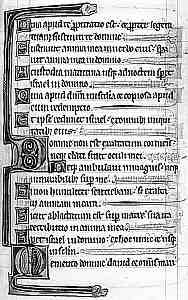
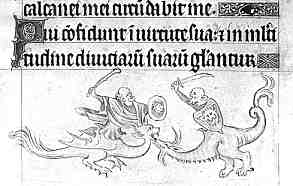
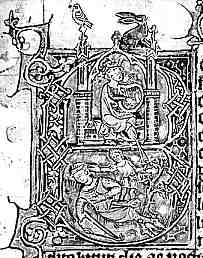
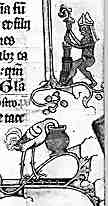
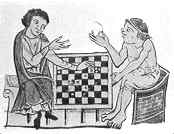
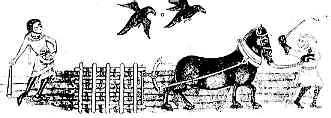
If you are looking at this page without frames, there is more information about medieval writing to be found by going to the home page (framed) or the site map (no frames).
| The Psalter (3) | ||||
 |
Page from a 13th century Flemish psalter (British Library, Royal 2 B III, f.144), by permission of the British Library. | |||
| This example shows the basic elements of page layout of a psalter of this era. It is laid out in a single column, usual if not universal. The lines of text are set out in a spacious manner as for reading aloud, with the blank ends of lines occupied by various decorative line fillers. They may seem to have no function, but they must help with keeping the place on the page. Note that they are all different. Each verse starts with an enlarged initial, which would be coloured and gilded, while larger initials mark the beginnings of important sections. The script is a large Gothic textura which is not too horizontally crammed, but there are a number of abbreviations, all of standard type. | ||||
 |
Marginal image from the early 14th century Queen Mary's Psalter (British Library, Royal 2 B VII), by permission of the British Library. | |||
| This work from the royal collection has the same basic layout, with somewhat more elaborate and intricate capitals and line fillers. It also has a set of illustrations in the bottom margins of each page that are, well, odd. | ||||
| There are a series of illustrations from the bestiary, little genre scenes, animal antics with monkeys dressed up in human clothing, and strange monstrous creatures. Whatever their relevance, or lack of it, to the text, they individualise each page. Given that the psalter was not read from beginning to end, the visual imprinting of the page may help form associations which allow the correct reading for the appropriate day to be located. | ||||
| The early 14th century ushered in a period of extravagant decoration, in architecture as well as in book production. Drolleries and satire also formed part of both the plastic arts and manuscript painting in the most sacred places. | ||||
 |
At left, the Beatus initial from the beginning of a Flemish psalter of the late 13th or early 14th century. At right, some marginal decoration from another leaf. (British Library, add. ms. 30029), by permission of the British Library. |  |
||
| Historiated initials generally bore some obvious relationship to the text, and the introductory initial to the psalter shows King David playing his harp, and the young David knocking off Goliath. I'm not sure about the rabbit. | ||||
| On the other hand, the relevance of a bird with its head in a pot, or a monkey wearing a bishop's mitre and churning butter with his crozier, to praises of the Lord is a little obscure. This was the era when they started depicting monkeys peering into urine flasks in cathedral windows and foxes in friar's garb preaching to geese on carved wooden misericords. Perhaps, in the vocabulary and syntax of the time, these were very recognisable little memory joggers. | ||||
| Marginalia sometimes also included scenes of everyday life, or something approximating to it, and have been a source of our visual conception of the middle ages. | ||||
 |
 |
|||
| At left, men playing draughts, from a 13th century Psalter in the Library of the Duke of Rutland Belvoir Castle. At right, a scene of seed sowing, from the Luttrell Psalter, now in the British Library. (From The New Palaeographical Society 1905and 1904) | ||||
| While we, with our modern perspective, might be tempted to be distracted by all this detail, the main significance of the work was in the sacred texts, which are presented boldly and legibly in formal scripts. The elaborately decorated and glamorous books have survived as prestige objects, either in monastic libraries or private collections. Probably many more basic works were produced, to act as practical service books, and for the learning of the liturgy. | ||||
| |
||||
If you are looking at this page without frames, there is more information about medieval writing to be found by going to the home page (framed) or the site map (no frames). |
||||